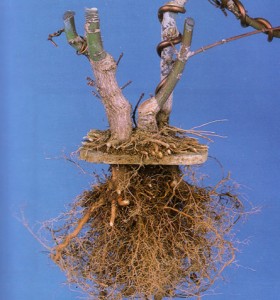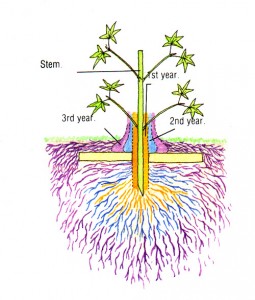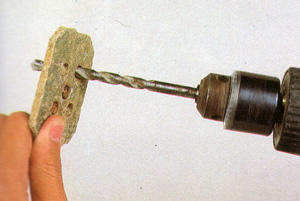
Can you figure out what’s going on here? If you are an experienced bonsai enthusiast, you may get it at a glance, especially if you’ve seen Bonsai Today issue 8 (long out of print). If what’s going on is not so evident, take a look at the drawing below and see if that helps.

This technique for developing mind bending nebari (surface roots) is so simple that pretty much anyone can do it. The species used here is Japanese maple (Acer palmatum), though the technique will no doubt work on other deciduous cuttings. All you need to try it is: a cutting (or cuttings), a piece of tile, and a drill (see below) with a 1/4″ (.6cm) bit. If you want to develop a single trunk bonsai, drill one hole. For a double trunk tree, drill two holes and so on. The photo above shows a triple trunk tree that was developed from five cuttings (two were left on to thicken the nebari and bases of the other trunks, and then removed).

If what’s going on is still not clear don’t worry; sometime next week I’ll post some more graphics and a few more words that should help. Meanwhile, you’ve got some food for thought.
By the way, even though Bonsai Today 108 is out of print, more than half of the original 108 issues are still in print, with a range of interesting and valuable techniques for your enjoyment.
Cool! So after three years, you could feel reasonably safe about cutting the first year tap root and let the third year nebari that have developed take over?
I would go by when the new roots look well enough developed to support the tree, rather than a fixed time.
When you do cut the old roots off, be sure to top prune so the new roots don’t have to support any more foliage than necessary while the tree is recovering.
Let me rephrase my original comment above:
Because conditions vary, three years may or may not work for you. What is important is the development of the nebari and the health of the tree. If the nebari looks good, then I would assume the roots supporting it will be healthy.
When you do cut the old roots off, be sure to top prune so the new roots don’t have to support any more foliage than necessary while the tree is recovering.
Love this method! I am currently trying this with several small Beaucarnea recurvata plants. I have planted them tighly together in a small clay pot. When they grow closer together I will use a net of string mesh to force them to combine.